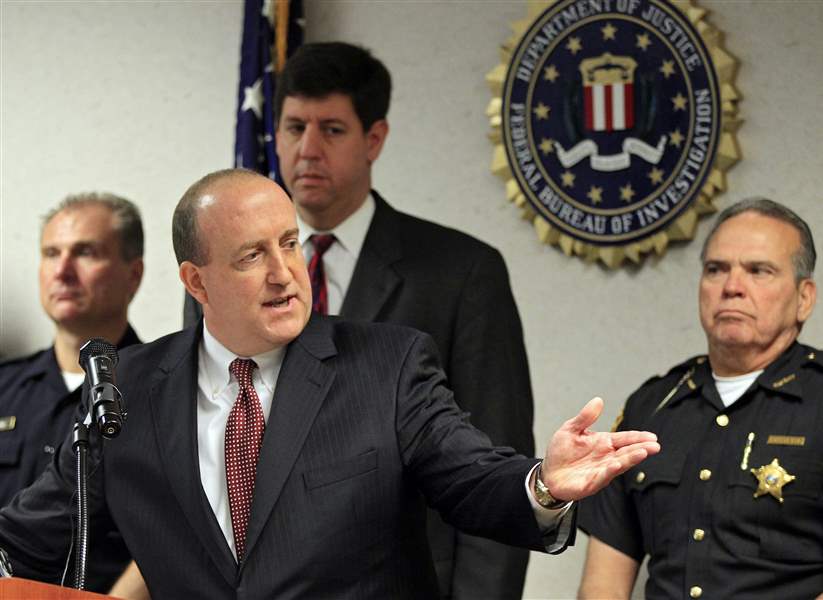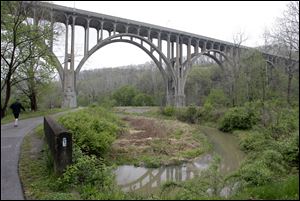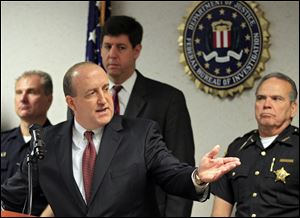
5 face terror charges in plot to blow up Cleveland bridge
5/1/2012
FBI Special Agent in Charge Stephen Anthony points to a map of an attempted bridge bombing at the bureau's office in Cleveland.
Associated Press

A man walks along the tow path approaching the Station Road Bridge at the Cuyahoga Valley National Park in Brecksville, Ohio, which the FBI says was targeted in a terrorism plot.
CLEVELAND — Self-proclaimed anarchists text-messaged a four-digit code into a cellular phone Monday night, expecting to detonate eight packs of plastic explosives strapped to a concrete abutment of a much-traveled bridge spanning the Cuyahoga River, federal officials charged Tuesday.
The five men waited at an unspecified spot near the State Rt. 82 bridge between Sagamore Hills and Brecksville, FBI agents said, hoping to watch the pillars collapse.
But there was no explosion, no bridge collapse, and by Tuesday afternoon the five men were appearing in U.S. District Court on federal terrorism charges that reference possible attacks on other landmarks, including Cleveland's Federal Reserve Bank.
At a news conference, U.S. Attorney Steven Dettelbach identified the men as members of a radical fringe of the Occupy Cleveland group, a national movement formed to protest corporate greed and home foreclosures.
Mr. Dettelbach said all evidence points to the five suspects acting alone, without the sanction of other Occupy members. "Let me be clear: The FBI and Department of Justice are not conducting an investigation of any specific group," he said. "We do not investigate movements or groups, we investigate individuals."
For nearly seven months, a confidential informant who had penetrated the group's inner circle secretly recorded meetings in which they plotted mayhem against symbols of corporate America in Greater Cleveland, Mr. Dettelbach and the FBI said. The unidentified informant reported back to the FBI.

FBI Special Agent in Charge Stephen Anthony points to a map of an attempted bridge bombing at the bureau's office in Cleveland.
Douglas Wright, 26, of Indianapolis was one of the leaders from the start, according to a 21-page affidavit filed by the lead FBI agent on the case. The suspects started by thinking small, with plans to topple the signs of banks from atop downtown Cleveland skyscrapers. The plot included a diversionary tactic of smoke bombs exploding on the Detroit-Superior (Veterans Memorial) Bridge.
Mr. Wright, alias Cyco, and the confidential informant were later joined by Brandon Baxter, 20, of Lakewood, Ohio, Anthony Hayne, 35, of Cleveland, Joshua Stafford, 23, of Cleveland, and Connor Stevens, 20, of Berea, Ohio. They attended Occupy Cleveland protests in attempts to recruit like-minded anarchists but were unsuccessful, the affidavit said.
Their plots ranged through schemes to blow up the Cuyahoga County Justice Center, the Federal Reserve Bank of Cleveland, the I-480 bridge in Valley View, and a cargo ship before they settled on the Ohio 82 bridge, according to federal documents. Other potential targets included the abandoned streetcar tunnels beneath downtown Cleveland, a Cuyahoga County Homeland Security operation called the Northeast Ohio Regional Fusion Center, an unidentified Ku Klux Klan location in Ohio, and the new Horseshoe Casino on Public Square.
All were eventually discounted for a variety of reasons, officials said.
The gang's bible, officials said, was the Anarchist Cookbook, a 1970 how-to manual on building bombs using household items and dealing with police during riots.
Rather than make their own bombs, the group eventually opted to buy C-4, a plastic explosive, plus bullet-resistant vests and gas masks, for $800. What they didn't realize was that the seller was an undercover FBI agent and the bombs were fakes -- inert devices built to look real, with wires, switches, and detonators that could be triggered by a call from a cell phone.
At their court appearances, the suspects said little. U.S. Magistrate Greg White found them all indigent and appointed them lawyers. They will be held without bond until at least Monday.
"The defendants went to the bridge last night," Dettelbach said at a news conference Tuesday morning. "The defendants planted the explosives at the base of a busy bridge. The defendants went to an offsite location to arm the explosives, and the defendants then entered a code they thought would blow that bridge up."
Dettelbach said the arrests show the evolving nature of terrorism the FBI is confronted with.
"This case demonstrates that the threat we face is a diverse one," he said. "That terrorism can come in many hues and from many homelands."
At their court appearances, the suspects said little.
U.S. Magistrate Greg White found them all indigent and appointed them lawyers. They will be held without bond until at least Monday.
"Love you, Connor," shouted James Stevens, father of suspect Connor Stevens, as federal marshals led the group away. Stevens' sister cried in the back of the courtroom.
Debbie Kline of Cleveland's Jobs with Justice coordinated with Occupy Cleveland on a number of protests and community actions. On Tuesday, she called the involvement of the five bombing suspects "fringey."
Baxter, she said, had recently attended a training session on nonviolent action. Kline said he seemed young and could have been impressionable.
"I wonder who else was pulling the strings of those in the group?" she said.
On Tuesday night, about 50 Occupy Cleveland members met behind closed doors at Trinity Cathedral.
Before the session, several members expressed concern over how this would affect the image of Occupy Cleveland. One entered the meeting room saying, "Are we ever going to be crucified in the media for this."
Matthew Revelt, 37, of Cleveland said, "I felt betrayal and disappointment. We knew these guys, but we didn't know them well enough nor did we know enough of their motives.
"Please tell the public that we're not bad people. Don't condemn the whole movement because of these five guys."
Johnny Peskar, 22, of Garfield Heights, said that Occupy Cleveland is a peaceful movement but that the incident has tarnished both the group and its goals.
"It's like saying you condemn the whole U.S. Army in Afghanistan because some soldiers went off on their own and shot innocent citizens," Peskar said. "These guys acted alone. They give the general public the wrong idea of what Occupy Cleveland is really about."